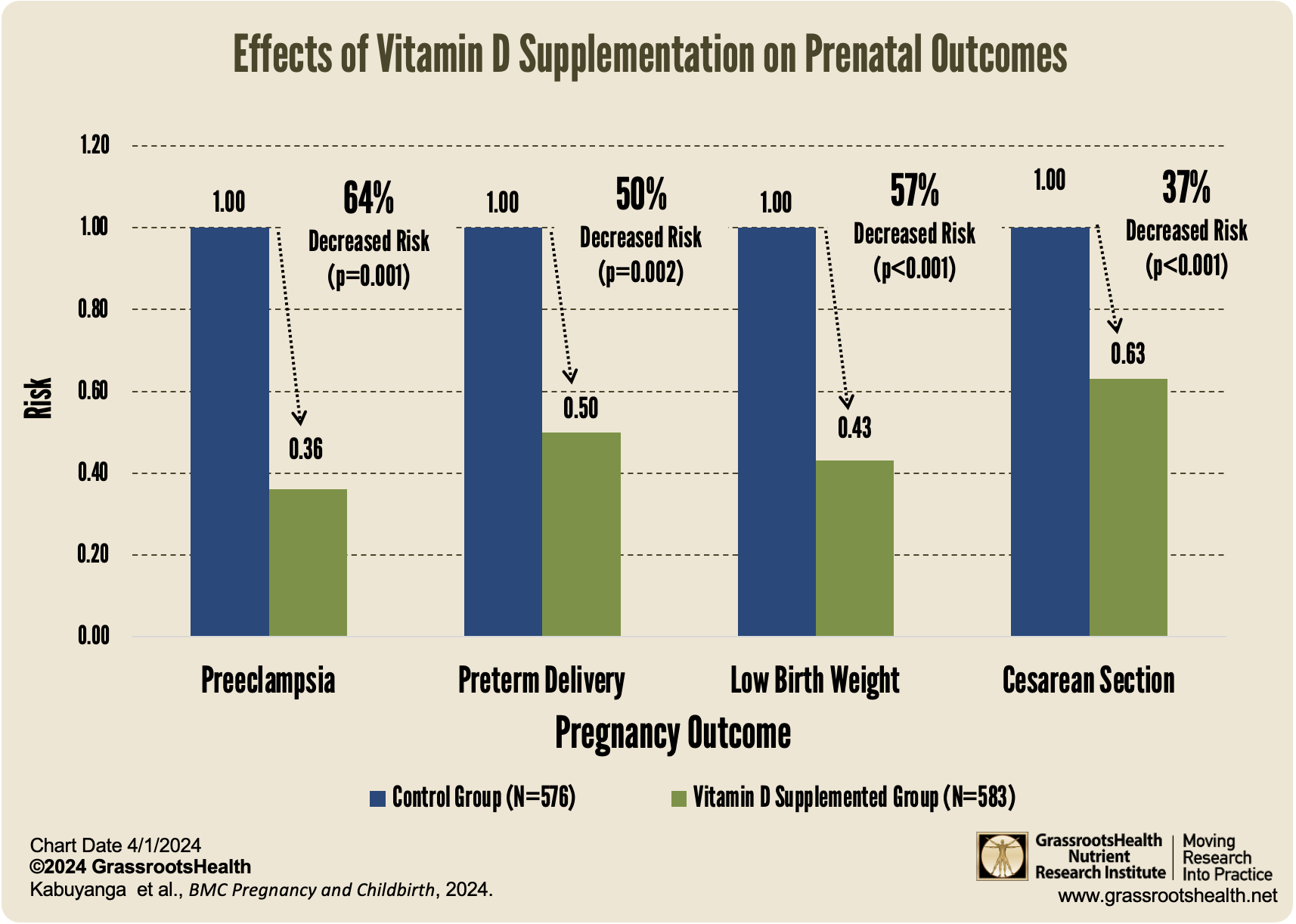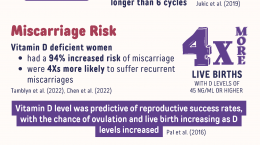Published on April 2, 2024
Women given vitamin D throughout pregnancy experienced significantly decreased risks of preeclampsia, preterm delivery, low birth weight, cesarean section and more
Key Points
- Studies continue to demonstrate the benefits associated with higher vitamin D levels during pregnancy, such as a recent study by Amiri et al., which found a 60% reduction in cesarean section, 93% reduction in preeclampsia, and 96% reduction in preterm birth among women whose vitamin D levels were higher compared to those whose levels were lower
- A newly published randomized controlled trial (RCT) by Kabuyanga et al. demonstrated the effects of vitamin D supplementation among pregnant women in the Eastern Democratic Republic of the Congo found that, compared to women who did not receive vitamin D, those receiving vitamin D experienced a 64% decreased risk of preeclampsia, 50% decreased risk of preterm delivery, 37% decreased risk of cesarean section, and more
- 20% of the women in the vitamin D supplementation group were still vitamin D deficient at the end of the study, indicating the need for higher doses of vitamin D during pregnancy; Weiss et al. found that a higher dose of 4400 IU vitamin D per day was still not optimal for all pregnant women, leaving 25% below 30 ng/ml, and African American women had the lowest levels overall
 Vitamin D is absolutely essential to a healthy pregnancy and baby – unfortunately, a majority of women do not get enough vitamin D during pregnancy. Prenatal vitamin D deficiency has been linked to many negative outcomes, including early onset severe preeclampsia, low birth weight, preterm birth, gestational hypertension, and more.
Vitamin D is absolutely essential to a healthy pregnancy and baby – unfortunately, a majority of women do not get enough vitamin D during pregnancy. Prenatal vitamin D deficiency has been linked to many negative outcomes, including early onset severe preeclampsia, low birth weight, preterm birth, gestational hypertension, and more.
New studies continue to demonstrate the benefits associated with higher vitamin D levels during pregnancy, such as a recent study by Amiri et al., which found a 60% reduction in cesarean section, 93% reduction in preeclampsia, and 96% reduction in preterm birth among women whose vitamin D levels were higher compared to those whose levels were lower. Another study by GrassrootsHealth and the Medical University of South Carolina found a 62% lower risk of preterm birth for women whose vitamin D level reached at least 40 ng/ml (100 nmol/L) during pregnancy compared to women below 20 ng/ml (50 nmol/L).
New Study Results on Prenatal Vitamin D Supplementation
A newly published randomized controlled trial (RCT) by Kabuyanga et al. demonstrated the effects of vitamin D supplementation among pregnant women in the Eastern Democratic Republic of the Congo. The study enrolled 1300 women from 14 different hospitals and health centers. All women entered the study at 16 weeks or less of gestation and were randomized to either receive 60,000 IU of oral vitamin D monthly (which is equivalent to approximately 2000 IU per day), with a total of 6 doses over 6 months, or no vitamin D supplementation. (Note: Learn why daily dosing is recommended over monthly dosing.) Vitamin D and calcium levels were measured at enrollment and at 34 weeks gestation.
At end of study, 576 women remained in the control group, and 583 women in vitamin D group. Compared to the women who did not receive vitamin D, those in the vitamin D group experienced a
- 64% decreased risk of preeclampsia (there was nearly a 3 times greater risk of preeclampsia in non-supplemented group!)
- 50% decreased risk of preterm delivery
- 57% decreased risk of low birth weight
- 37% decreased risk of cesarean section
APGAR scores at the 5th minute and newborn size were also significantly higher among babies born to women in vitamin D group. All of the above findings were statistically significant.
Not Enough Vitamin D…
It is important to note that 20% of the women in the vitamin D supplementation group were still vitamin D deficient at the end of the study! This indicates the need for higher doses of vitamin D during pregnancy, as was also found in a recent study by Weiss et al.. This study found that a higher dose of 4400 IU vitamin D per day was not optimal for all pregnant women to achieve a vitamin D level of 30 ng/ml, concluding that such a dose is likely not high enough of a general recommendation during pregnancy. In this study, only 75% of the women receiving 4400 IU/day in the vitamin D group reached a level of at least 30 ng/ml, and African American women had the lowest levels overall. No adverse effects were observed among both the mothers and the babies at this dose.
This also highlights the importance of an individualized supplement dose based on current vitamin D levels. Everyone responds differently to vitamin D supplementation and will require a different amount of vitamin D to reach and maintain optimal levels. Had the above study supplemented in this way, the study results would likely have been even more positive.
If you or someone you know is pregnant or trying to get pregnant, supplementing to achieve a vitamin D level of at least 40 ng/ml as early as possible (preferably before conception) is an easy and effective way to improve the health of the pregnancy and baby. Learn more here.
How Are Your Levels of Vitamin D and Other Important Nutrients?
Do you know what your vitamin D level is? Check yours along with omega-3s, magnesium, and other levels today as part of the vitamin D*action project; add the Ratios for more about how to balance your Omega-3s and 6s!
Measure your:
- Vitamin D
- Magnesium PLUS Elements
- Omega-3 Fatty Acids
- hsCRP (for Inflammation)
- HbA1c (for Blood Sugar)
- and more
Did you know that each of the above can be measured at home using a simple blood spot test? As part of our ongoing research project, you can order your home blood spot test kit to get your levels, followed by education and steps to take to help you reach your optimal target levels. Start by enrolling and ordering your kit to measure each of the above important markers, and make sure you are getting enough of each to support better mood and wellbeing!
Build your custom kit here – be sure to include your Omega-3 Index along with your vitamin D.
Start Here to Measure Your Levels







